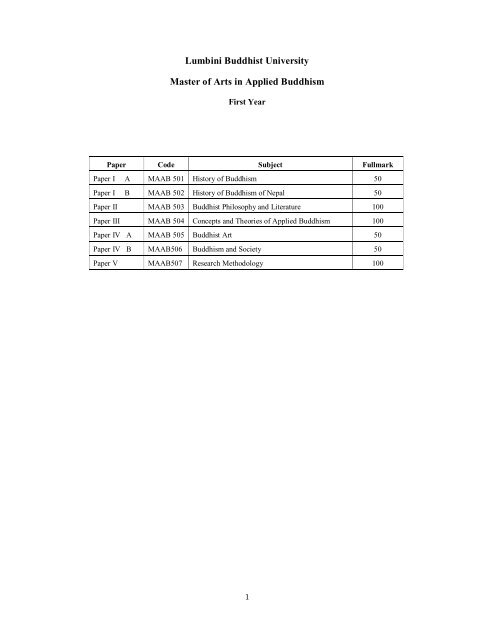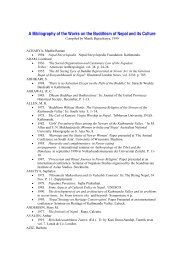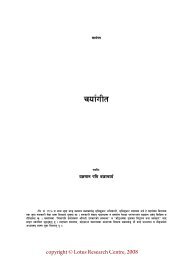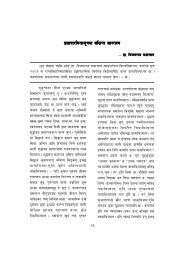A PDF file with the details of the first year of the M.A. courses can be
A PDF file with the details of the first year of the M.A. courses can be
A PDF file with the details of the first year of the M.A. courses can be
Create successful ePaper yourself
Turn your PDF publications into a flip-book with our unique Google optimized e-Paper software.
Lumbini Buddhist UniversityMaster <strong>of</strong> Arts in Applied BuddhismFirst YearPaper Code Subject FullmarkPaper I A MAAB 501 History <strong>of</strong> Buddhism 50Paper I B MAAB 502 History <strong>of</strong> Buddhism <strong>of</strong> Nepal 50Paper II MAAB 503 Buddhist Philosophy and Literature 100Paper III MAAB 504 Concepts and Theories <strong>of</strong> Applied Buddhism 100Paper IV A MAAB 505 Buddhist Art 50Paper IV B MAAB506 Buddhism and Society 50Paper V MAAB507 Research Methodology 1001
Paper I ABuddhism: History and DevelopmentLevel: MA Applied BuddhismFirst YearPaper – I AMAAB 501 - Buddhism: History and DevelopmentFull mark 50Teaching Hours: 75Course objective:1. This syllabus is expected to provide overall information <strong>of</strong> history <strong>of</strong> Buddhism from <strong>the</strong> advent <strong>of</strong><strong>the</strong> Buddha to various historical phases <strong>of</strong> Buddhism, its philosophical development and expansionin o<strong>the</strong>r countries. Such knowledge will certainly enable students to proceed to learn o<strong>the</strong>r aspects<strong>of</strong> Buddhism.Unit 1 Introduction to Buddhism 10a. Buddhism as a religion and Philosophyb. The life <strong>of</strong> <strong>the</strong> Buddhac. Buddhist CouncilsUnit 3 Formation <strong>of</strong> Eighteens Nikayas 10a. Formation <strong>of</strong> different Nikayasb. Introduction to Mahasanghika, Sarvastivada and VibhajjavadaUnit 4 Rise <strong>of</strong> Mahayana Buddhism 15a. Evolutionb. Early Features <strong>of</strong> MahayanaUnit 5 Buddhist Universities in Ancient India 15a. Over View <strong>of</strong> Taxila, Nalanda, Vikramsila and Odantapurib. Their role in development <strong>of</strong> BuddhismUnit 6 Growth and Development <strong>of</strong> Tantric Buddhism 15a. Origin and Expansionb. Main FeaturesUnit 7 Expansion <strong>of</strong> Buddhism 10Suggested Readingsa. Expansion in South and South East Asiab Expansion in North East Asiac. Decline <strong>of</strong> Buddhism in India1. Conze, Edward, A Short History <strong>of</strong> Buddhism, London: George Allen and Unwin, 1980.2. Dhammika, Ven. S., The Edicts <strong>of</strong> King Ashoka, Kandy: Buddhist Publication Society, 1994.3. Dharmananda, K. Sri, Buddhism as a Religion, Kuala Lumpur: Sasana Abhiwurdi Wardhana Society, 1994.4. Dutt, Nalinaksha, Buddhist Sects in India, Delhi: Motilal Banarsidass, 1987.5. Dutt, Sukumar, Buddhist Monks and Monasteries <strong>of</strong> India: Their History &Their Contributions To IndianCulture, London: George Allen and Unwin, 1962.6. Dutt, Sukumar. Early Buddhist Monachism. New Delhi: Munshiram Manoharlal, 1984.7. Hazara, Kanailal, The Rise and Decline <strong>of</strong> Buddhism in India, New Delhi: Munshi Ram Manohar Lal, 1998.2
8. Hirakawa, Akira, A History <strong>of</strong> Indian Buddhism: From Shakyamuni to Early Mahāyāna, Honolulu:University <strong>of</strong> Hawaii Press, 1990.9. Lamotte, Étienne, History <strong>of</strong> Indian Buddhism, tr. Sara Webb-Boin, Louvain: Peeters Press, 1988.10. Leitich, Keith A., ‘The Rise and Decline <strong>of</strong> Buddhism in Central Asia;, In: Shanker Thapa (ed.),Nor<strong>the</strong>rn Buddhism in History, Kathmandu: Vajra Publications, 2005.11. Lester, R.C. Theravada Buddhism in Sou<strong>the</strong>ast Asia. Ann Arbor: University <strong>of</strong> Michigan Press, 1973.12. Malalgoda, Kitsiri. Buddhism in Sinhalese Society 1760-1900, Berkeley: Univ. <strong>of</strong> California Press, 1976.13. Pande, G C, Studies in <strong>the</strong> Origins <strong>of</strong> Buddhism, Allahabad: University <strong>of</strong> Allahabad, 195714. Prebish, Charles S., Buddhism: A Modern Perspective, University Park: The Pennsylvania State UniversityPress, 1994.15. Sarao, K T S, The Decline <strong>of</strong> Indian Buddhism: A Fresh Perspective, New Delhi: Munshiram Manoharlal,2012.16. Sarao, KTS, “Da Tang Xiyuji and O<strong>the</strong>r Chinese Sources on <strong>the</strong> Decline <strong>of</strong> Buddhism in India,” In: PremKumari Pant et al (eds.), Buddhism: <strong>the</strong> Icon <strong>of</strong> Cultural Linkage <strong>with</strong> China, Kathmandu: Nepal ChinaSociety, 2010: 181-214.17. Schumann, H. W., The Historical Buddha: <strong>the</strong> Times, Life and Teachings <strong>of</strong> <strong>the</strong> Founder <strong>of</strong> Buddhism, NewDelhi: MLBD, 2004.18. Seneviratna, Anuradha (ed.), King Ashoka and Buddhism Historical and Literary Studies, Kandy: BuddhistPublication Society, 1994.3
Level: MA Applied BuddhismFirst YearPaper – I BMAAB 502 - History <strong>of</strong> Buddhism <strong>of</strong> NepalFull mark 50Teaching Hours: 75Course objectives:Paper I BHistory <strong>of</strong> Buddhism <strong>of</strong> Nepal1. Since Nepal is <strong>the</strong> birth place <strong>of</strong> <strong>the</strong> Buddha, study <strong>of</strong> Buddhism has <strong>be</strong>come very important forNepalese. Nepal also has a long history <strong>of</strong> lively Buddhist culture. This course will provide opportunityto students to understand historical development <strong>of</strong> Nepalese Buddhism, Buddhism in <strong>the</strong> Himalayanregion, present status <strong>of</strong> Theravada Buddhism. It will also help students to know about BuddhistSanskrit Mss <strong>of</strong> Nepal.Unit 1 Mythological Tradition <strong>of</strong> Nepalese Buddhism. 5Unit II Buddhism during <strong>the</strong> Licchavi, Medieval and Modern Periods. 15Unit III Newar Buddhism –History, Scholarship, Monasticism,Sangha, Rituals, Festivals, Practices (Vrata, Dana, Charya etc)and Textual Tradition. 25Unit IV Buddhism in Nor<strong>the</strong>rn Nepal. 15a. Buddhism in <strong>the</strong> Khasa Kingdom.b. Ti<strong>be</strong>tan Buddhism in nor<strong>the</strong>rn Nepal and Kathmandu.Unit V General Survey <strong>of</strong> Theravada Buddhism in Nepal. 5Unit VI Buddhist Sanskrit Manuscripts <strong>of</strong> Nepal. 10a. Origin, Development and Signifi<strong>can</strong>ce.b. Preservation <strong>of</strong> Mss Native and foreign repositories.Suggested Readings1. Adhikari, Surya Mani, The Khasa Kingdom : A Trans-Himalayan Empire <strong>of</strong> <strong>the</strong> Middle Age, Jaipur:Nirala Publication, 1997.2. Bajracharya Mana Vajra, Mythological History <strong>of</strong> <strong>the</strong> Nepal Valley from Svayambhu Purana,Kathmandu; Avalok Publisher, 1978.3. Douglas-Tuladhar, Will, Remaking Buddhism for Medieval Nepal: The Fifteenth-Century Reformation<strong>of</strong> Newar Buddhism, London: Routledge, 2006.4. Gellner, David N., Monk, Householder, and Tantric Priest. Newar Buddhism and its Hierarchy <strong>of</strong>Ritual, Cambridge: Cambridge University Press, 19925. Kloppen<strong>be</strong>rg, Ria, ‘Theravada Buddhism in Nepal’, Kailash, Vol. 5, 1977, 301-321.6. Levine, Sarah and David Gellner, Rebuilding Buddhism: The Theravāda Movement in TwentiethCentury Nepal, Cambridge Mass.: Harvard University, 2005.7. Locke, John K., Buddhist Monasteries <strong>of</strong> Nepal, Kathmandu: Sahayogi Press, 1985.8. Locke, John, Karunamaya: The cult <strong>of</strong> Avalokitesvara in <strong>the</strong> Valley <strong>of</strong> Nepal, Kathmandu: CNAS,1985.4
9. Pandey, Ram Niwas, Making <strong>of</strong> Modern Nepal: A Study <strong>of</strong> History, Art, Culture <strong>of</strong> Western Nepal,Jaipur: Nirala Publication, 1998.10. Pant, Prem Kumari, et al (ed.), Buddhism: <strong>the</strong> Icon <strong>of</strong> Cultural Linkage <strong>with</strong> China, Kathmandu: NepalChina Society, 2010.11. Pradhan, Bhuvan L., Nepalma Bouddha Dharma, Kathmandu; Royal Nepal Academy, 1990.12. Rajendra Ram, History <strong>of</strong> Buddhism in Nepal (A.D. 704-1396), Patna: Janabharati Prakashan, 197713. Regmi, D R, Medieval Nepal, 2 Vols., Calcutta: K L Mukhopadhyaya, 1972.14. Shakya, Min B. and Shanta Harsha Bajracharya (tr.), Svayambhu Purana, Lalitpur: NIEM, 1997.15. Shrestha, Khadga Man, History <strong>of</strong> Buddhism <strong>of</strong> Nepal <strong>with</strong> Special Reference to Vajrayana Buddhism<strong>of</strong> Nepal, Kathmandu: Kamala Devi Shrestha, 2008.16. Thapa, Shanker and Indra Kumari Bajracharya, Ratnakar Mahavihara, A Vajrayana BuddhistMonastery <strong>of</strong> Patan, New Delhi: Adroit Publisher, 2005.17. Thapa, Shanker, Buddhist Monasticism in Theory and Practice, Kathmandu: Walden Books, 1995.18. Thapa, Shanker, Buddhist Sanskrit Literature <strong>of</strong> Nepal, Seoul: Minjoksa Publishing Co., 2005.19. Thapa, Shanker, 'History <strong>of</strong> Nepalese Buddhism: From Mythological Tradition to <strong>the</strong> Licchavi Period',Voice <strong>of</strong> History, Vol. XVI, No. 2, 2001 Dec.20. Thapa, Shanker, Newar Buddhism: History, Scholarship and Literature, Lalitpur: NagarjunaPublications, 2005.21. Vajracharya, Dhanavajra, Licchavikalka Abhilekh, Kirtipur: Asiyali Anusandhan Kendra, 2030 VS22. Vajracharya, Dhanavajra and K.P. Malla (ed.), The Gopalrajsavamsavali, Nepal Research CenterPublication No. 9, Wiesbaden; Franz Stiener Verlag, 1985.5
Paper IIBuddhist Philosophy and LiteratureLevel: MA Applied BuddhismFirst YearPaper – IIMAAB 503 - Buddhist Philosophy and LiteratureFull mark 100Teaching Hours: 150Course objectives:1. Philosophy and literary aspects are <strong>the</strong> core in studying Buddhism. This course will facilitatestudents to learn about <strong>the</strong> philosophical aspect <strong>of</strong> Buddhist. This paper is <strong>the</strong> key to all o<strong>the</strong>rsubjects <strong>of</strong> Buddhism..Unit I Pre - Buddhist Philosophies 10a. Buddhism and Contemporary philosophies six nonBuddhist Philosophersb. Vedic and Shramana traditionsUnit II Basic Buddhist Philosophy 20a. Four Noble Truths and <strong>the</strong>ory <strong>of</strong> Dependent Origination.b. Four Seals <strong>of</strong> BuddhismAnitya (All compounded things are impermanent),Dukha (All stained emotions are painful),Anatma (All phenomena are empty), andNirvana (Nirvana is peace).c. Samatha and Vipassana.Unit III Basic Introduction Four Philosophical Foundations 25a. Vaibhasika.b. Sautantrika.c. Madhyamika.d. Yogacara.Unit IV Buddhist Epistemology and Logica. Concept <strong>of</strong> Direct Perception and inference 30b. Eminent Buddhist thinkersMadhyamika – Nagarjuna and AryadevaYogacara – Asanga and VasubandhuLogic (Pramana) – Dingnaga and DharmakirtiVinaya – Gunaprabha and SilaprabhaUnit V Formation <strong>of</strong> Pali Literature 15a. Origin and development <strong>of</strong> Pali TripitakaSuttaVinayaAbhidhammaAttakathaAnupitakaUnit VI Formation <strong>of</strong> Sanskrit Tripitaka 20a. Origin and development <strong>of</strong> Sanskrit literature6
AgamaSutra,Vinaya,Abhidharma,TantraShastra.Unit VII Translated Canons - Origin and Development. 15a. Ti<strong>be</strong>tan Tripitakab. Chinese Tripitakac. Korean Tripitakad. Mongolian TripitakaUnit VIII Buddhist Tripitaka in <strong>the</strong> Digital age 15Suggested Readingsa. e-resources <strong>of</strong> Buddhist manuscripts,e-books and translations <strong>of</strong> Buddhist texts1. Barua, Benimadhab., A History <strong>of</strong> Pre-Buddhist Indian Philosophy, Delhi: MLBD, 1970.2. Beal, Samuel, Buddhist Tripitaka as it is Known in China and Japan, London: Clarke and Son, 1876.3. Bodhi, Bhikkhu, The Connected Dis<strong>courses</strong> <strong>of</strong> <strong>the</strong> Buddha: A Translation <strong>of</strong> <strong>the</strong> Samyutta Nikāya,Boston: Wisdom Publications, 2000,4. Chatterjee, Ashok Kumar Chatterjee, Yogacara Idealism, Delhi: MLBD, 1997.5. Dreyfus, Georges B. J., Recognizing Reality: Dharmakirti’s Philosophy and Its Ti<strong>be</strong>tan Interpretations,NY: SUNY Press, 1997.6. Gombrich, Richard F, Theravada Buddhism: A Social History from Ancient Benares to ModernColombo, New York: Routledge, 2006,7. Harris, I., The Continuity <strong>of</strong> Madhyamaka and Yogacara in Indian Mahayana Buddhism, Leiden: EJBrill, 1991.8. Harvey, Peter, An Introduction to Buddhism: Teachings, History and Practices, Cambridge: CambridgeUniversity Press, 1990,9. Hattori, Masaaki, trans. Dignāga, On Perception: Being <strong>the</strong> Pratyaksapariccheda <strong>of</strong> Dignāga’sPramānasamuccaya from <strong>the</strong> Sanskrit Fragments and <strong>the</strong> Ti<strong>be</strong>tan Versions. Cambridge: HarvardUniversity Press, 1968.10. Kalupahana, David J, Buddhist Philosophy: A Historical Analysis, Honolulu: Univ <strong>of</strong> Hawai’i Press,1975.11. Kalupahana, David J,, A History <strong>of</strong> Buddhist Philosophy: Continuities and Discontinuities, Honolulu:University <strong>of</strong> Hawaii Press, 1992.12. Laumakis, Stephen J, An Introduction to Buddhist Philosophy, Cambridge: Cambridge Univ Press, 2008.13. Law, Bimala Curna, A History <strong>of</strong> Pali Literature, London: Kegan Paul, Trench, Trubner and Co., 1933.14. Lindtner, Chrarles, Nagarjuniana: Studies in <strong>the</strong> Writings and Philosophy <strong>of</strong> Nagarjuna, Copenhagen:Akademisk Forlag, 1982.15. Lusthaus, Dan, Buddhist Phenomenology: A Philosophical Investigation <strong>of</strong> Yogacara Buddhism and <strong>the</strong>Ch’eng Wei-shih lun, London: Curzon Press, 2003,16. Matilal, Bimal Krishna and Ro<strong>be</strong>rt D. Evans (eds.), Buddhist Logic and Epistemology: Studies in <strong>the</strong>Buddhist Analysis <strong>of</strong> Inference and Language, Dordrecht: D. Reidel Publishing Co, 1986.17. Matilal, Bimal Krishna, The Character <strong>of</strong> Logic in India, New York: SUNY Press, 1998.18. McCagney, Nancy, Nāgārjuna and <strong>the</strong> Philosophy <strong>of</strong> Openness, Lanham: Rowman and Littlefield, 1997,19. Murti, T.R.V, The Central Philosophy <strong>of</strong> Buddhism, London: George Allen & Unwin, 1960.7
20. Nagao, Gadjin M. Mādhyamika and Yogācāra, NY: SUNY Press, 1991.21. Narada Thera, The Buddha and His Teachings, Taipei: CBBEF, 1995.22. Nariman, G.K., Literary history <strong>of</strong> Sanskrit Buddhism, Delhi: MLBD, 1992.23. Omvedt, Gail, Buddhism in India Challenging Brahmanism and Caste, New Delhi: Sage Publication,2003.24. Piyadassi Thera, Buddha’s Ancient Path, Kandy: Buddhist Publication Society, 1974.25. Poppe, Nicholas. The Twelve Deeds <strong>of</strong> Buddha, Seattle: University <strong>of</strong> Washington Press, 1967.26. Prebish, Charles S, Buddhist: A Modern Perspective, University Park: University Park, ThePennsylvania State University Press, 1994.27. Rajapakse, Reginton, ‘Buddhism as Religion and Philosophy,’ Religion, Vol. 16, 1986, 51–55,28. Ronkin, Nora, Early Buddhist Metaphysics: The Making <strong>of</strong> a Philosophical Tradition, New York:Routledge Curzon, 2005,29. Ruegg, David S., The Literature <strong>of</strong> <strong>the</strong> Madhyamaka School <strong>of</strong> Philosophy in India. Wiesbaden: OttoHarrassowitz, 1981.30. Sangharakshita, Maha Sthavira. The Eternal Legacy: An Introduction to <strong>the</strong> Canonical Literature <strong>of</strong>Buddhism. London: Tharpa, 1985.31. Santina, Peter de la, The Tree <strong>of</strong> Enlightenment, Taiwan: Chico Dharma Study Foundation, 1997.32. Shaw, Sarah, Buddhist Meditation: An Anthology <strong>of</strong> Texts from <strong>the</strong> Pali Canon, Routledge CriticalStudies in Buddhism, London: Routledge, 2006.33. Stcherbatsky, F. Theodore. Buddhist Logic, Vols. I and II. New York: Dover, 1930.34. Suzuki, D.T., Outlines <strong>of</strong> Mahāyāna Buddhism. New York: Schocken, 1963.35. Upadhyaya, Baldev, Bauddha Darshan Mimamsa, Varanasi: Chaukhamba Vidyabhavan, 1978.36. Walapola, Rahula, What <strong>the</strong> Buddha Taught: Revised and Expanded Edition <strong>with</strong> Texts from Suttas andDhammapada, NY: Grove Press, 1974.37. Watana<strong>be</strong>, Fumimoro, Philosophy and Its Development in <strong>the</strong> Nikāyas and Abhidhamma, Delhi: MLBD,1983,38. Wayman, Alex, A Millennium <strong>of</strong> Buddhist Logic, Delhi: MLBD, 1999.39. Williams, Paul and Anthony Tri<strong>be</strong>, Buddhist Thought: A Complete introduction to <strong>the</strong> Indian tradition,London: Routledge, 2000.40. Williams, Paul, Mahayana Buddhism: The Doctrinal Foundations, London: Routledge, 1989.41. Winternitz, Maurice, History <strong>of</strong> Indian Literature, Vol. 2: Buddhist & Jain Literature, Delhi: MLBD,1998.8
Paper IIIConcepts and Theories <strong>of</strong> Applied BuddhismLevel: MA Applied BuddhismFirst YearPaper – IIIMAAB 504 - Concepts and Theories <strong>of</strong> Applied BuddhismFull mark 100Teaching Hours: 150Course objective:Unit I Conceptual Aspects <strong>of</strong> Applied Buddhism 15a. Definition, Concepts and Signifi<strong>can</strong>ceb. Origin – History and reasonsc. Orthodox Buddhism Vs Applied Buddhismd. Applying Buddhist principles in daily life and self cultivationUnit II Buddhist Modernism 30a. Buddhist Modernism – an overviewb. Bechert and Buddhist modernism(Buddhistische Modernismus)c. Lopez’s concept <strong>of</strong> Buddhist modernismd. Buddhist romanticism – its rootse. Buddhism in <strong>the</strong> west - departure to modernityf. DT Suzuki as a Buddhist Modernist and spread <strong>of</strong> Zenin <strong>the</strong> westUnit III Contemporary Buddhist Movements 25a. Engaged Buddhism –- Introduction and <strong>the</strong> Fourteen Guidelines- Engaged Models - Tzu Chi, Indramang, Sarvodaya Shramadana,b. Lay Buddhisi Movementc. Navayana Buddhism in India (<strong>the</strong> Hermeneutics <strong>of</strong>Buddhist Li<strong>be</strong>ration)d. Shakyadita Movemente. Green Buddhist MovementUnit IV Transformation <strong>of</strong> Buddhism 15a. Brief survey <strong>of</strong> modern versions <strong>of</strong> Buddhismb. Introduction and Philosophy <strong>of</strong> Won Buddhismand Nichiren ShoshuUnit V Modern Buddhist Thinkers and Ideological Contributions 30a. Thich Nhat hanhb. Sheng Yenc. Daisaku Ikedad. Sulak Sivaraksae. B. R. Am<strong>be</strong>dkar (Hermeneutics <strong>of</strong> Buddhist Li<strong>be</strong>ration)f. Buddhadasa Bhikshu9
g. S N Goenkah. Henry Steel Oolcotti. Anagarika Dhammapala (Buddhist Nationalism and Protestant Buddhism)j. Sonam Gyatsok. DT Suzukil. Sangharakshita (Neo-traditional Buddhism in India)Unit V Buddhism and Globalization 15Suggested Readingsa. Survey <strong>of</strong> Buddhism in <strong>the</strong> westb. Impact <strong>of</strong> Buddhism in <strong>the</strong> western society1. Ahir, D. C., Buddhism and Am<strong>be</strong>dkar, New Delhi, Ajay Parkashan, 1968.2. Aitken, Ro<strong>be</strong>rt, New Mahayana: Buddhism for <strong>the</strong> Postmodern World. Berkeley, Asian HumanitiesPress, 1991.3. Barua, Deepak Kumar, Applied Buddhism: Studies in <strong>the</strong> Gospel <strong>of</strong> <strong>the</strong> Buddha from ModernPerspective, Varanasi: Center <strong>of</strong> Buddhist Studies – BHU, 2005.4. Baumann, Martin. ‘Global Buddhism: Developmental Periods, Regional Histories, and a New AnalyticPerspective,’ Journal <strong>of</strong> Global Buddhism 2 (2001): 1–43.5. Bechert, Heinz and Jens - Uwe Hartman, 'Observations on <strong>the</strong> Reform <strong>of</strong> Buddhism in Nepal',Journal <strong>of</strong> Nepal Research Center, Vol. VIII, 1988.6. Bechert, Heinz, ‘Buddhistic Modernism: Its Emergence, Impact and New Trends,’ Business &Economic Review 14, 1990, pp. 93-1047. Bechert, Heinz, ‘Buddhistic Modernism: Present Situation and Current Trends.’ In: Buddhism into <strong>the</strong>Year 2000: International Conference Proceedings, 251–60. Bangkok: Dhammakaya Foundation, 1994.8. Coleman, James William. The New Buddhism: The Western Transformation <strong>of</strong> an Ancient Tradition.New York: Oxford University Press, 2001.9. Dharmapala, Anagarika. Return to Righteousness: A Collection <strong>of</strong> Speeches, Essays and Letters <strong>of</strong> <strong>the</strong>Anagarika Dharmapala. Ceylon: Government Press, 1965.10. Eppsteiner, Fred (ed.), The Path <strong>of</strong> Compassion: Writings on Socially Engaged Buddhism, Berkeley:Parallax Press, 1985.11. Heine, Steven and Charles S. Prebish, Modern World: Adaptations <strong>of</strong> an Ancient Tradition, Oxford:Oxford University Press, 2003.12. Hoang, D.X., A Buddhist Socioeconomic system - lessons from <strong>the</strong> Sarvodaya Shramadana Movementin Sri Lanka, , http://www.buddhanetz.org/texte/sarvoday.htm13. Humphreys, Christmas. Zen Comes West: The Present and Future <strong>of</strong> Zen Buddhism in Western Society.London: Curzon Press, 1977.14. Inada, Kenneth. Buddhism and Ameri<strong>can</strong> Thinkers. Albany: State University <strong>of</strong> New York Press, 1984.15. Jones, Ken, New Social Force <strong>of</strong> Buddhism: A Call to Action, London: Wisdom Books, 2003.16. Lopez, Donald S., Jr. (ed.) A Modern Buddhist Bible: Essential Readings from East and West. Boston:Beacon Press, 2002.17. Lory, David, The Great Awakening: A Buddhist Social Theory, London: Wisdom Books, 2003.18. McMahan, David L., The Making <strong>of</strong> Modern Buddhism, Oxford: Oxford University Press, 2005.19. Nhat Hanh, Thich, Inter<strong>be</strong>ing: Fourteen Guidelines for Engaged Buddhism Fred Eppsteiner (ed.),Berkeley: Parallax Press, 1998.20. Park, Pori, 'New Visions for Engaged Buddhism: The Jungto Society and <strong>the</strong> Indra's Net CommunityMovement in Contemporary Korea', Contemporary Buddhism, 11: 1, 2010, pp. 27- 46.21. Queen, Christopher S. and Sallie B. King. Engaged Buddhism: Buddhist Li<strong>be</strong>ration Movements inAsia. Albany: State University <strong>of</strong> New York Press, 1996.22. Queen, Christopher, Action Dharma: New Studies in Engaged Buddhism. London: Routledge, 2003.10
23. Queen, Christopher, ed. Engaged Buddhism in <strong>the</strong> West, London: Wisdom Books, 1999.24. Sharma, Anita, ‘Socially Engaged Buddhist Activities in Contemporary Korea’, In: S Narsimhan andD. Y. Kim, (ed.), Korea and India: A Forging Relationship, New Delhi: Manak Publications, 2005, pp.279-294..25. Sharma, Anita, ‘Tzu Chi: A Case Study <strong>of</strong> Engaged Buddhism in Taiwan’, In: Anita Sharma and S.Chakravarti, Taiwan Today, New Delhi: An<strong>the</strong>m Press, 2007.26. Tsomo, Karma Lekshe, ed. Sakyadita: Daughters <strong>of</strong> <strong>the</strong> Buddha. Ithaca, NY: Snow Lion, 1989.27. Tsomo, Karma Lekshe. Sisters in Solitude: Two Traditions <strong>of</strong> Buddhist Monastic Ethics for Women.Albany, NY: State University <strong>of</strong> New York Press, 1996.28. Wilkinson, T. S. and Thomas M. M., Am<strong>be</strong>dkar and <strong>the</strong> Neo-Buddhist Movement, Bangalore: ChristianLiterature Society, 1972.29. Won Buddhism: The Historical Context <strong>of</strong> Sot’aesan’s Reformation <strong>of</strong> Buddhism ‘, In Heine, Stevenand Charles S. Prebish Ed.), Buddhism in <strong>the</strong> Modern World: Adaptations <strong>of</strong> an Ancient Tradition,Oxford: Oxford University Press, 2003.11
Chapter IV ABuddhist Art <strong>of</strong> NepalLevel: MA Applied BuddhismFirst YearPaper – IV AMAAB 505 - Buddhist Art <strong>of</strong> NepalFull mark 50Teaching Hours: 75Course objective:Unit I Development <strong>of</strong> Buddhist art 10a. Origin <strong>of</strong> Buddhist artb. Symbolic art in Early Buddhismc. Evolution <strong>of</strong> Buddha and Bodhisattva ImagesUnit II History <strong>of</strong> Indian Art 15a. Gandhara Art – Introduction and features,b. Mathura art - Introduction and features,c. Guptae. Pala - Sena style <strong>of</strong> art - Main features and influencein Nepal and Ti<strong>be</strong>tUnit III Nepalese Art 30a. Brief History <strong>of</strong> Hindu and Buddhist art <strong>of</strong> Nepalb. Nepalese Buddhist Paintings and Sculptures1. Paintingsa. Early Buddhist paintingsb. Buddhist Manuscript Paintingsc. Fresco paintings <strong>of</strong> Kathmandu valleyd. Paubha paintings and its features2. Sculpturesa. Early Buddhist stone sculpturesb. Important Bronze sculpture <strong>of</strong> Nepalc. Wood carvings <strong>of</strong> NepalUnit IV Iconography <strong>of</strong> Buddhist deities 15a. Theoretical aspectsb. Iconography <strong>of</strong> selected deitiesc. Vajrasattva, Vajradhara,d. Lokeshvara: Padmapani and Sadaksarie. Manjusri: Namasangiti and Manjughosaf. Tantric deities: Cakrasamvara and Hevajra.Unit V Art and Ritual 5a. Brief introduction to Ritual Artb. Making <strong>of</strong> MandalaSuggested Readings1. Bhattacharya, Benoytosh, Indian Buddhist Iconography, Calcutta: K. L. Mukhopadhyaya, 1972.12
2. Coomaraswamy, A.K., Elements <strong>of</strong> Buddhist iconography, New Delhi: Munshiram Manoharlal.1998.3. Asthana, Shashi Prabha, Mathura Kala, New Delhi: National Museum, Janpath, 1999.4. Coomaraswamy,A.K, The Origin <strong>of</strong> Buddha Image, New Delhi: Munshiram ManoharlalPublishers, 2001.5. Getty, Alice, The Gods <strong>of</strong> Nor<strong>the</strong>rn Buddhism, New Delhi: Munshiram Manoharlal, 19786. Gordon, A.K., The iconography <strong>of</strong> Ti<strong>be</strong>tan Lamaism, New Delhi: Munshiram Manoharlal, 1978.7. Gupta, Rajatananda Das, Nepali Miniature, New Delhi: Bharatiya Vidya Bhawan, 2001.8. Jackson, David and Janice Jackson, Ti<strong>be</strong>tan Thangka Painting, London: Serindia Publications,1984.9. Kreiger, Hugo E., Kathmandu Valley Painting:- The Jucker Collection, London: Serindia Pub.,1999.10. Pal, Pratapaditya, The Art <strong>of</strong> Nepal, Leiden: E. J. Brill, 1985.11. Paul, Devajani, The Art <strong>of</strong> Nalanada, New Delhi: Munshiram Manoharlal, 1995.12. Ray, Amita, Art <strong>of</strong> Nepal, New Delhi: Indian Council for Indian culture, 1973.13. Shakya, Milan Ratna, Buddhas and Bodhisattvas, Kathmandu: CNAS, 2011.14. Shakya, Min B., Iconography <strong>of</strong> Nepalese Buddhism, Kathmandu: Nepal Handicraft Association,1994.15. Shakya, Min B., Sacred Arts <strong>of</strong> Nepal, Kathmandu: Handicraft Association <strong>of</strong> Nepal, 2000.16. Slusser, Mary S., Antiquity <strong>of</strong> Nepalese Wood Carving: A Reassessment, Washington: University<strong>of</strong> Washington Press, 2010.17. Slusser, Mary S., Art and Culture <strong>of</strong> Nepal Selected Articles, Kathmandu: Mandala Book Point,2005.18. Slusser, Mary Shepherd, Nepal Mandala: A Cultural Study <strong>of</strong> <strong>the</strong> Kathmandu Valley, 2 Vols,Princeton: Princeton University Press, 1982.19. The Arts <strong>of</strong> India and Nepal: The Nasli and Alice Heeramaneck Collection Museum <strong>of</strong> fine Arts,Boston: Museum <strong>of</strong> fine Arts, 1966.13
Paper IV BBuddhism and SocietyLevel: MA Applied BuddhismFirst YearPaper – IV BMAAB 506 - Buddhism and SocietyFull mark 50Teaching Hours: 75Course objective:Unit 1 Buddhism and Society – Study <strong>of</strong> Selected Suttas 25a. Gilana Sutta, Jivaka Sutta, Kula Sutta, Tapussa Sutta,Upajjhatthana Sutta, Sigalovada Sutta, Dhammika Sutta,Dighajanu Sutta, Kutadanta Sutta, Cakkavatti Sutta, Simhanada Sutta.Unit 2 Buddhism and Social Development 20a. Buddhism and Social Involvement.- Buddhist Social Principles and <strong>the</strong>ories.b. Buddhism in Syncratic Shape.c. Buddhist Approach to Social Development.d. Buddhism and Social Action (generosity, helping, [teaching], community service)Unit 3 Buddhism and Lay Society 151. Introduction and practice <strong>of</strong> lay Buddhism2. Vinaya for laity3. Laity and <strong>the</strong> SanghaUnit 4 Impact <strong>of</strong> Buddhist Teachings in <strong>the</strong> Modern Society 151. Theoretical framework to apply spiritual principles to collective social issues2. Impact <strong>of</strong> Buddha’s Teachings in Politics, economy and EnvironmentSuggested Readings1. Selected Suttas from Pali Nikaya2. Bechert, Heinz and Richard, Buddhism in <strong>the</strong> Modern World, London: Thames and Hudson, 19913. Bodhi, Bhikkhu, Facing <strong>the</strong> Future: Four Essays on Buddhism and Society, Kandy: Buddhist PublicationSociety, 20004. Jones, Ken, New Social Force <strong>of</strong> Buddhism: A Call to Action, London: wisdom books, 20035. Jones, Ken, Buddhism and Social Action: An Exploration, Kandy; Buddhist Publication Society, 1981.6. Loy, David, i<strong>the</strong> Great Awakening: A Buddhist Social Theory, , London: wisdom books, 20037. McMahan, David L., The Making <strong>of</strong> Buddhist Modernism. Oxford: Oxford University Press, 2008.8 Shoji, Rafael, ‘Buddhism in Syncretic Shape: Lessons <strong>of</strong> Shingon in Brazil’, Journal <strong>of</strong> GlobalBuddhism, Vol. 4, 2003.14
Paper VResearch MethodologyLevel: MA Applied BuddhismFirst YearPaper – VMAAB 506: Research Methodology, Manuscriptology and Textual CriticismFull mark 100 (Theory 80 and Field work 20)Teaching Hours: 120Course objective:Unit 1 Research in Buddhism and Buddhist Historiography 20a. Trends <strong>of</strong> research in Buddhismb. Buddhist Historiographyi. Generalii. NepalUnit 2 Sources and Types <strong>of</strong> Information 15a. Types <strong>of</strong> evidences to study Buddhism.b. Nature <strong>of</strong> information – original, primary and SecondaryUnit 3 Manuscriptology and Textual Criticism 25a. Manuscriptology -– Introduction and types,– Production, collection and usage,– Prominent Pali and Buddhist Sanskrit Mss collections in South Asiab. Historical Criticism - establishing au<strong>the</strong>nticity and credibility <strong>of</strong> evidencesin <strong>the</strong> study <strong>of</strong> Buddhismc. Textual Criticism - Importance and methodsUnit 4 Methods <strong>of</strong> Research in Buddhism 10a. The method - Historical and Survey methodsb. Identification <strong>of</strong> sources <strong>of</strong> informationUnit 4 Techniques <strong>of</strong> Social ScienceResearch methods <strong>with</strong> Special focus on Buddhism 20a. Types <strong>of</strong> Social Research – Qualitative and Quantitative Researchb. Methods <strong>of</strong> Social science Research <strong>with</strong> focus on Survey methodc. Methods <strong>of</strong> data collection – Interview, Questionnaires, Observationd. Development <strong>of</strong> Toolse. SamplingUnit 5 Practical Aspects <strong>of</strong> Research 15a. Selection <strong>of</strong> a topicb. Writing Research proposalc. Identification <strong>of</strong> sources and <strong>the</strong>ir Collectiond. Analysis <strong>of</strong> DataUnit 6 Writing 15a. Organizing15
. Writing research articles, reports and Dissertation – guidelinesc. Writing <strong>first</strong> draft <strong>of</strong> <strong>the</strong>sisd. Citation <strong>of</strong> footnotes and bibliography - various styles and use <strong>of</strong> Latinabbreviationse. The Final Report and its formatUnit 7 Field Work (FM: 20)Suggested readings(Students are required to submit a report prepared by applying different aspects<strong>of</strong> research methodology after field visit co-ordinated by <strong>the</strong> concernedPr<strong>of</strong>essor/Lecturer as part <strong>of</strong> training in Research Methodology. The campusrequires submitting <strong>the</strong> examined report to <strong>the</strong> Exam section/LBU that carries 20FM)1. Berkwitz, Stephen C., Buddhist History in <strong>the</strong> Vernacular: The Power <strong>of</strong> <strong>the</strong> Past in Late Medieval SriLanka, Leiden: Brill, 2004.2. Bingenheimer, Marcus, ‘Writing History <strong>of</strong> Buddhist Thought in <strong>the</strong> Twentieth Century: Yinshun(1906-2005) in <strong>the</strong> Context <strong>of</strong> Chinese Buddhist Historiography’, Journal <strong>of</strong> Global Buddhism, Vol.10, 2009.3. Katre, S. M., Introduction to Indian Textual Criticism, Dec<strong>can</strong> College Hand-Book Series 5, Poona1954.4. Murthy, R.S.S., Introduction to Manuscriptology, New Delhi: Sharada Publishing House, 1996.5. Perera, Frank, The Early Buddhist Historiography <strong>of</strong> Ceylon, n.p. 1979.6. Sarma, K.V., ‘Manuscriptology and Textual Criticism in Medieval India’, Indologica Taurinensia, Vol.10, 1982, pp. 281-288.7. Shafer, R. J., A Guide to Historical Method, Illinois: Dorsey Press, 1969.8. Storch, Tanya, ‘Chinese Buddhist Historiography and Orality’, Sino-Platonic Papers, No. 37, March,University <strong>of</strong> Pennsylvania 1993.9. Turabian, Kale L., A Manual <strong>of</strong> Writers <strong>of</strong> Term Paper, Chicago: University <strong>of</strong> Chicago, 1996.10. Young, Pauline V., Scientific Social Survey and Research, New Delhi: Prentice Hall, 2006.16







![g]kfn d)*n of af}B :jLs[lt %u](https://img.yumpu.com/52272195/1/184x260/gkfn-dn-of-afb-jlslt-u-cwoog-lotus-research-center.jpg?quality=85)